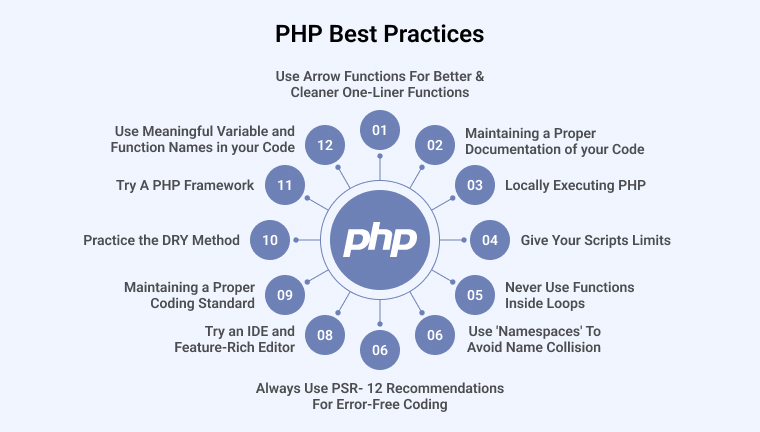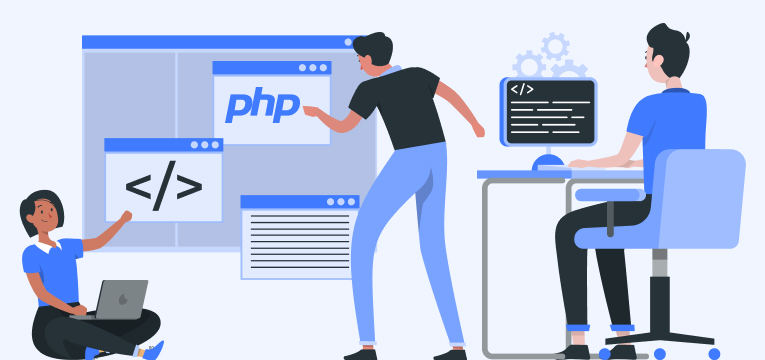Table of Content
- PHP Best Practices to Follow
- Try an IDE and Feature Rich Editor
- Always Use PSR- 12 Recommendations For Error-Free Coding
- Maintaining a Proper Documentation of Your Code
- Use 'Namespaces' To Avoid Name Collision
- Maintaining a Proper Coding Standard
- Try a PHP Framework
- Use Arrow Functions For Better & Cleaner One-Liner Functions
- Use Meaningful Variable and Function Names in Your Code
- Learn the DRY Approach
- Never Use Functions Inside Loops
- Give Your Scripts Limits
- Locally Executing PHP
- Conclusion
Top 12 PHP Best Practices for Web Developers
The PHP programming language is considered to be one of the most popular worldwide, and this article will hopefully provide you with some useful tips for getting started with it. Many PHP developers in India and world wide, both newcomers and seasoned professionals, fail to adhere to the language’s standard best practices.
Those who fail to pay care to language best practices frequently find themselves unqualified for high-paying positions. And it’s not easy for anyone to pick up the best methods on the fly.
If you’re serious about becoming a professional web developer, you need to become familiar with these below mentioned top 12 PHP best practices for web developers and begin incorporating them into your work as soon as possible.
1. PHP Best Practices to Follow
Below are a few PHP best practices to follow for better performance.

1.1 Try an IDE and Feature-Rich Editor
The beauty of PHP script is that it can be composed using Notepad and yet function perfectly on a web server, provided it is formatted appropriately. Nevertheless, without a full-fledged IDE or at least a feature-rich text editor, overall performance will suffer.
To get the most out of a language, an IDE (Integrated Development Environment) is a useful tool. PhpStorm is a popular IDE for the PHP programming language. Syntax highlighting, code completion, error messages, and reworking are just some of the features you get from them.
Some multipurpose text editors can also be used for coding. As an instance of a powerful editor that supports a wide variety of programming languages through the use of add-ons, consider using Visual Studio Code.
1.2 Always Use PSR- 12 Recommendations for Error-Free Coding
PSR-12 (PHP Standard Recommendations) is an alternative to the WordPress coding standard that is widely adopted. It is also utilized by the PHP frameworks Symfony and Laravel, making it one of the most significant benchmarks. It includes everything from parenthesis to managing structures, approaches, punctuation, line length, and coding guidelines concerning how many spaces PHP developers can leave among various code structures.
The reason is, modern language features aren’t supported by the antiquated WordPress standards. The use of PHP’s new PSR-2 features is also recommended.
1.3 Maintaining a Proper Documentation of Your Code
Keeping detailed records of your code is more crucial than you may have realized. It’s terrible that some PHP programmers, both new and experienced, don’t take the time to provide significant remarks to their code.
It improves readability for future readers of your code and serves as a useful memory aid for you as well. Let’s say you write a crucial function today and can recall its inner workings for a few days, maybe even a week. But there is enough potential for you to lose track of what it does, until a month or two afterwards when you evaluate it.
Therefore, it is always recommended to provide appropriate comments to ensure that your code is easily understood by everyone including yourself.
1.4 Use ‘Namespaces’ to Avoid Name Collision
In WordPress, the namespace is universal. Any classes or functions announced at the universal level can be used anywhere in the project. We must avoid naming disputes at all costs because they lead to mistakes.
For instance, naming collisions occur when you introduce a function with a name that is already present. Therefore, you can use something like this instead of boring old Class names like “Order.” Here’s a code snippet:
Syncrasy_Get_My_Plugin_Order |
where “Syncrasy” is a prefix to describe this phenomenon.
Namespaces aid in code organization and prevent duplicate names. It is also possible to use more complicated namespaces, such as those that are delimited by slashes.
For instance:
class Syncrasy_Get_My_Plugin_Order |
if we were using namespaces, it would be Syncrasy\_Plugin\Order. Order is the name of the class, while syncrasy and Get_My_Plugin are namespaces. The class name alone can be used once the use expression has been added.
Take a look:
use Syncrasy\Get_My_Plugin\Order; $a = new Order; |
1.5 Maintaining a Proper Coding Standard
Coding inconsistencies amongst coders working on the same project may quickly become a major headache, therefore it’s crucial to stick to a consistent set of rules.
If everyone involved with the source code creates their own codes of conduct, the project might quickly become uncontrollable. Some developers don’t bother with maintaining any kind of coding standard, and their code eventually looks like a giant heap of junk.
Keeping to a consistent coding style makes it simpler for others to troubleshoot your code and boosts the efficiency of team efforts.
1.6 Try a PHP Framework
Being creative with PHP frameworks is a great way to learn the PHP language. Frameworks like CakePHP and CodeIgniter make it easy to build PHP apps fast and without extensive knowledge of the programming language. They serve as a kind of PHP tutorial, walking you through the fundamentals of creating a web application in the language by demonstrating best practices.
However, it recommends starting with the fundamentals of the language and looking at a few smaller open-source projects to observe the developers’ coding styles before moving on to more complex endeavors.
1.7 Use Arrow Functions for Better & Cleaner One-Liner Functions
Even when only doing elementary tasks, PHP functions are notoriously cumbersome. The excessive amounts of syntactic boilerplate and the requirement to explicitly import frequently used variables are to blame. Because of this, even reading and understanding PHP code snippets that employ only simple closures may be a daunting task.
Features like variadics, default values, parameter and return types, and by-reference passing and returning are all possible using arrow function syntax. All while preserving a codebase that can be easily read.
Here is a glimpse of PHP 7.4’s Arrow Function Syntax:
array_map(function (Product $product) { return $product->price * 1.1; }, $products); |
With PHP 7.4, you can write code like this:
array_map(fn (Product $prod) => $prod->price * 1.1, $products); |
1.8 Use Meaningful Variable and Function Names in Your Code
If you don’t follow a suitable naming convention and use generic and meaningless names everywhere, it might become a challenge for other programmers to comprehend your code. It’s not a healthy habit, and you shouldn’t get into it.
Name your variables and functions as something relevant and correctly formed, and make it a routine to separate each word with an underscore. And make an effort to adhere consistently to the norm you’ve set so that others can learn your convention with ease.
1.9 Practice the DRY Method
Don’t Repeat Yourself (DRY) is a helpful principle in programming that transcends language barriers. The goal of Don’t Repeat Yourself (DRY) programming is, unsurprisingly, to avoid duplicating effort. Take Reinhold Weber’s example below:
$mysqli = mysqli_connect('localhost', 'database_user', 'secret_password'); mysqli_select_db('wp_database') or die("cannot select DB"); |
now with the DRY approach:
$db_host = 'localhost'; $db_user = 'database_user'; $db_password = 'secret_password'; $db_database = 'wp_database'; $mysqli = mysqli_connect($db_host, $db_user, $db_password); mysqli_select_db($db_database); |
1.10 Never Use Functions Inside Loops
A common error that is usually noticed among programmers is to call functions from within a loop. If you’re doing this on purpose and willing to sacrifice performance to shave off a single line of code, you should reconsider.
Inappropriate Practice:
for ($j = 0, $j <= count($array); $j++) { //code } |
Appropriate Practice:
$count = count($array); for ($j = 0; $j < $count; $j++) { //code } |
If you store the value returned by the function in an independent variable prior to the loop, you can save a lot of time running the program. In the initial instance, the function will be identified and run every time the loop is executed, which can make the program harder to run if it has a lot of loops.
1.11 Give Your Scripts Limits
Limiting the execution of PHP programs is essential. When your PHP scripts crash, you may prevent endless loops and database connection timeouts by using the set_time_limit method. The set_time_limit function restricts the duration of a script’s execution to a specified number of seconds which is 30 by default. A fatal error is raised once that time has passed.
1.12 Locally Executing PHP
There’s a good chance you’ll want to keep everything you do on your computer, including the actual coding, if you’re building PHP applications.
To do this, you need just access to a web server and a scripting language like PHP. MySQL is necessary for any task requiring access to a database, such as signups, login validation, etc.
While it is possible to install each component individually, there are easier ways to set up a local server in a matter of minutes using solutions like XAMPP, WAMP, or MAMP.
2. Conclusion
Historically, PHP best practices have centered on making life easier for programmers. Not to mention, it is an object-oriented programming language. Before investing time and energy in a project, it’s important to weigh the pros and cons carefully. The latest ideas in PHP programming provide a straightforward, simple method for creating applications.

Hardik Dhanani has a strong technical proficiency and domain expertise which comes by managing multiple development projects of clients from different demographics. Hardik helps clients gain added-advantage over compliance and technological trends. He is one of the core members of the technical analysis team.
To develop responsive and dynamic websites, read and write web files, and keep track of sessions, PHP serves as one of the most widely used...
 Aug 16, 2023
Aug 16, 2023 



Firstly, thank you very much for putting together all of these PHP best practices. This is a great resource for people like me who don't want to have to go through so many websites just to find what they're looking for.
To be honest, I expected more from this blog but It didn't live up to my expectations. You did mention some common PHP best practices. There are more best practices that you can add to this blog. I hope you update this blog in the future. Thanks!